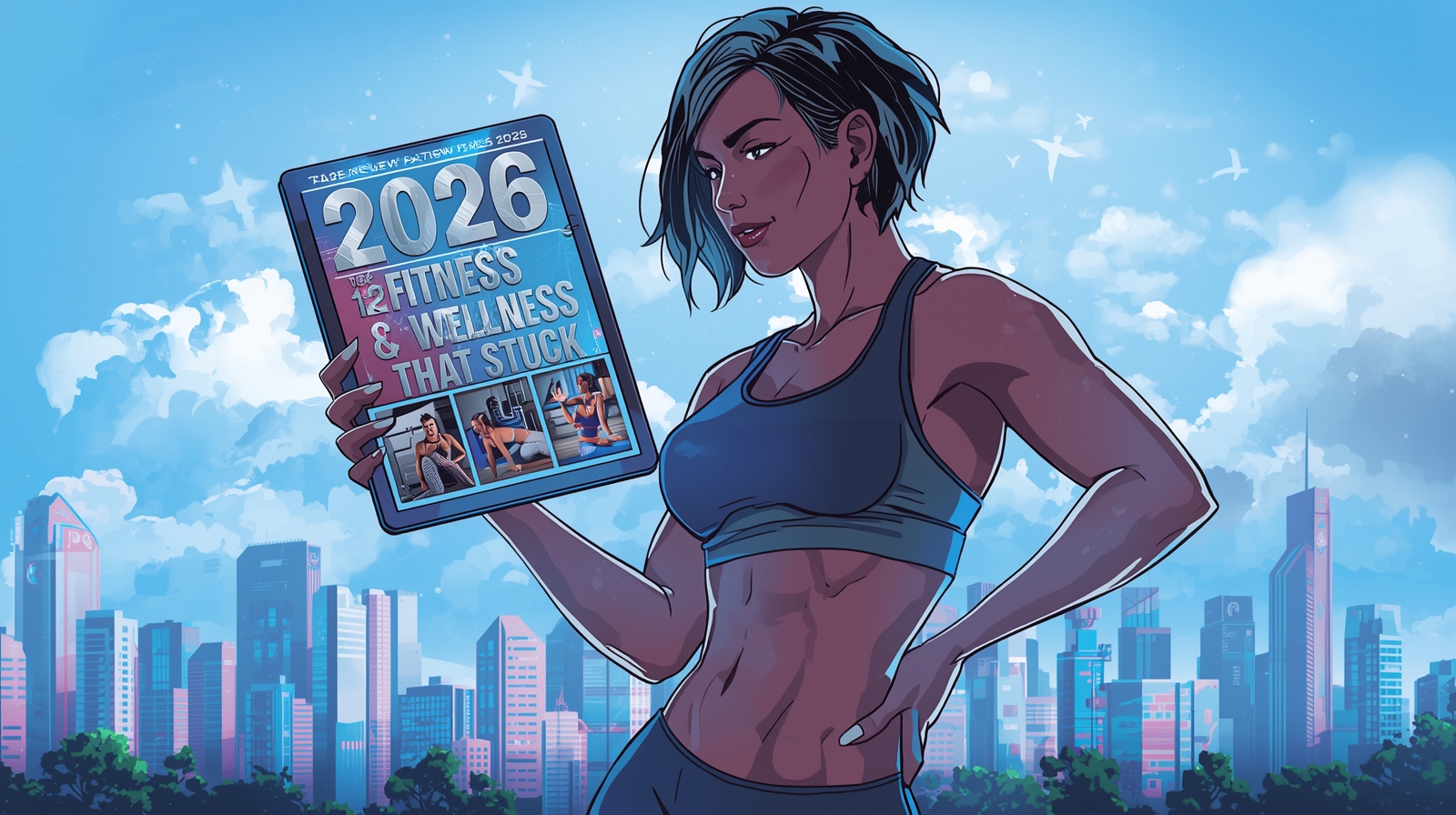2026 wasn’t a year of flashy gimmicks. It was the year people stopped chasing the newest flashy trend and started asking, “Does this actually help me live better?” That question shaped fitness and wellness in small, practical ways. We saw tech become quieter, workouts get shorter but smarter, and wellness become a part of daily life — like brushing your teeth, but less minty.
In this article I’ll walk you through the top 12 trends that didn’t just make headlines in 2026 — they stuck. Each trend is explained plainly, why it worked, who it helped, and a quick tip to try it yourself.
Trend 1: Micro-Workouts — big results in small bites
Micro-workouts are short, intense sessions you can do anywhere: a 7-minute bodyweight circuit, three tabata rounds during a lunch break, or 10 pushups between meetings. In 2026, people embraced micro-workouts because they removed the biggest barrier: time.
Why it stuck: people are busy. Short workouts reduce decision fatigue and make consistency possible.
Who benefits: busy professionals, parents, people returning after a break.
Quick tip: pick one 7–10 minute routine you can do daily. Consistency beats intensity when time’s tight.
Trend 2: Mental Fitness as Daily Practice
Mental fitness stopped being a once-a-week meditation trend and became a daily practice. Think short mental workouts: breath control, focused attention, and micro-reflections. Apps helped, yes, but so did simple habits — journaling for five minutes or a breathing break after emails.
Why it stuck: stress is persistent; short daily practices were easier to keep than long retreats.
Who benefits: everyone. Especially those with anxiety, high-pressure jobs, or poor sleep.
Quick tip: set a 3-minute mental fitness alarm twice a day. Close your eyes, breathe, and notice.
Trend 3: Nutrition Personalization Goes Mainstream
Personalized nutrition moved from niche labs to everyday recommendations. Not just DNA kits — practical tailoring based on how people feel after meals, simple blood markers, and food diaries combined with coaching.
Why it stuck: people saw quick gains — less bloating, better sleep, steady energy — from small, tailored changes.
Who benefits: anyone with digestive issues, energy slumps, or a desire to lose stubborn weight.
Quick tip: keep a three-day food-and-feel log. Note what you ate and how you felt afterward; look for patterns.
Trend 4: Workplace Wellness Reimagined
Offices didn’t go back to the 2010s status quo. Companies invested in real wellness: flexible schedules, movement breaks built into the day, private spaces for rest, and mental health support.
Why it stuck: productivity rose when companies stopped pretending hustle alone equals success.
Who benefits: employees, teams, and employers who want retention.
Quick tip: if your workplace offers nothing, start a 10-minute group stretch at lunch. Small culture shifts grow fast.
Trend 5: Sleep Tech Becomes Basic Gear
Instead of expensive gadgets promising miracles, sleep tech in 2026 became thoughtful and cheap: smart bulbs that gently shift light, simple under-mattress sensors, and apps that coach regular sleep windows.
Why it stuck: better sleep shows results fast — better mood, sharper thinking, fewer cravings.
Who benefits: shift workers, parents, students, anyone with poor sleep habits.
Quick tip: pick one sleep habit to change for 30 days — consistent wake time is easiest and most powerful.
Trend 6: Group Movement, But Offline Again
After a long period of virtual classes, people craved real human energy. Community-based fitness — neighborhood classes, park bootcamps, and small studios — grew. The vibe was social and casual, not intense club culture.
Why it stuck: human connection motivates. People stayed consistent because their friends did.
Who benefits: social exercisers, beginners, and anyone who dislikes solo workouts.
Quick tip: join a walking group or weekend class — accountability beats motivation.
Trend 7: Low-Impact Longevity Training
The fitness world embraced sustainability for the body. Low-impact training (swimming, cycling, eccentric strength work) aimed at maintaining function and joint health over decades, not just aesthetics.
Why it stuck: as people aged, they prioritized movement that felt good long-term.
Who benefits: older adults, injury-prone people, and anyone who plans to stay active for life.
Quick tip: add a weekly low-impact session — 30 minutes of cycling or a gentle pool workout.
Trend 8: Sustainable Fitness — eco-friendly gains
From gyms using recycled materials to brands offering repairable gear, sustainability found its way into fitness. People cared about the planet and wanted their workouts to reflect that.
Why it stuck: consumers prefer brands that match their values; gyms that saved energy saved money.
Who benefits: planet-conscious consumers and businesses.
Quick tip: check the longevity of gear before buying. Materials and repair policies matter.
Trend 9: Biofeedback & Simple Wearables
Fancy health metrics are out; actionable metrics are in. Wearables focused on simple feedback — recovery readiness, stress balance, and movement quality — instead of a flood of confusing numbers.
Why it stuck: clear signals lead to clear actions, like rest or a light workout.
Who benefits: athletes and everyday users who want guidance without analysis paralysis.
Quick tip: use one wearable metric (e.g., readiness score) to guide today’s training: train hard when ready, rest when not.
Trend 10: Movement Snacks at Home & Office
Movement snacks are tiny, deliberate bursts of activity — a two-minute calf raise session, 20 squats while water boils, or desk yoga between calls. They accumulated into meaningful weekly activity.
Why it stuck: they’re easy to do and add up.
Who benefits: desk workers, caregivers, and anyone who sits a lot.
Quick tip: place sticky notes in key spots: stand and march in place during ad breaks.
Trend 11: Mental Health + Physical Health Integration
This was the year physical health and mental health stopped living in separate silos. Therapy, coaching, fitness, and nutrition worked together for whole-person care.
Why it stuck: problems are rarely isolated; treating the whole person produces better results.
Who benefits: people with chronic conditions, mood issues, or performance goals.
Quick tip: if you’re starting therapy or a coach, share your physical routine. Integration helps.
Trend 12: Fitness for Function — real-world strength
People wanted to be strong for life tasks: carrying groceries, playing with kids, or climbing stairs. Training emphasized practical strength, mobility, and balance over mirror-based aesthetics.
Why it stuck: functional fitness is the most useful kind of fitness.
Who benefits: everyone, especially older adults and parents.
Quick tip: practice loaded carries (a heavy bag walk) and single-leg balance drills twice a week.

Conclusion — What to keep and what to skip
2026 taught a simple lesson: small, consistent, and sensible changes stick. The trends that survived were practical, inclusive, and focused on long-term gains. Flashy fads faded; habits that produced clear results — better sleep, more movement, stronger social ties — stayed.
Keep: daily mental fitness, micro-workouts, sleep routines, and community movement.
Skip: overly complex gadget stacks and one-size-fits-all diets.
Final thought: pick one trend from this list, try it for a month, and see how you feel. Fitness and wellness aren’t a finish line — they’re better tools for living. And if you want, I can make this article longer, add images, or convert it into a listicle or social posts.


